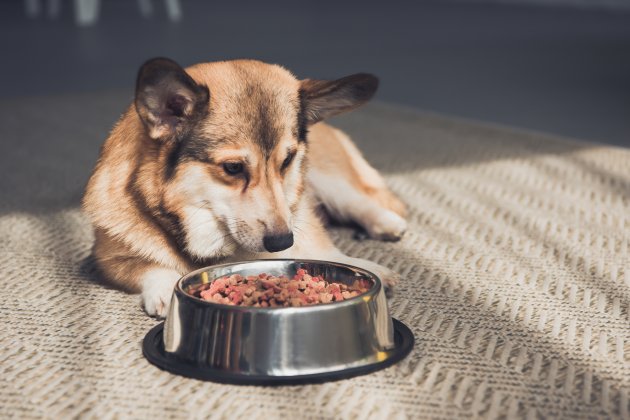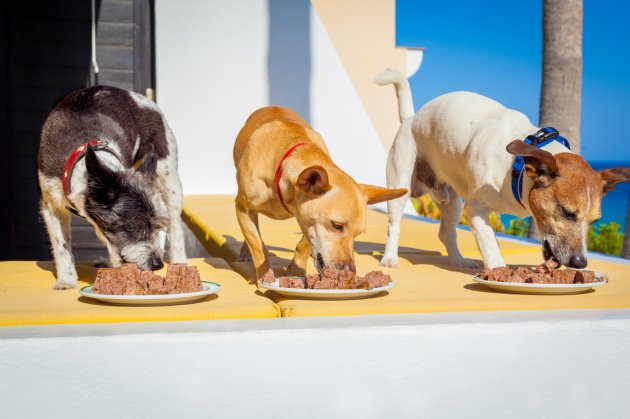With the internet today, many dog food myths quickly spread, and now people think that these statements are true. These myths are heard by veterinarians every day about food and they have to tell people what is the actual truth. Here are the most popular myths about dog food that are not true.
Myth 1: My dog needs to eat grain-free food.
Dogs do not need to eat grain-free food. Recently studies have shown that grain-free food can cause heart problems. These heart problems are not always reversible. Grains provide your dog with a good source of carbohydrates, which is needed for energy. Grains also contain fiber, which helps your dog's gastrointestinal tract. Grains very rarely cause allergies in dogs.

Myth 2: My dog needs to eat dry food only.
Dry food is a great easy way to feed your dog. There is no worrying about canned food going bad or what to do if your dog does not eat all the wet food in one sitting. Dogs can be fed a mixture of wet and dry food. Many veterinarians think that this may be the best way to feed your dog. The wet food helps provide your dog with added moisture. The dry food is excellent and keeping their teeth healthy and strong. If your dog does have some tartar on their teeth, the dry kibbles will help knock the tartar off while they are chewing. If their dental disease is severe, dry kibble will not help, and your dog will need professional dental cleaning.
Myth 3: All dog food sold at retail stores are suitable for my dog.
While most dog food sold at pet stores are completely balanced and great for your dog, some foods do not meet the minimum requirements to be well-balanced dog food. When looking for dog food, make sure that the dog food has an AAFCO statement on the bag. This statement means that the dog food is completely balanced. Not all dog food that is entirely balanced and contains all the needed nutrients are suitable for your dog. Making sure that the food is full of protein and not just fillers will help your dog live a happy and healthy life.

Myth 4: All table food is bad for your dog.
Many people think that they should never feed their dog food from the table. While most of the time this is true, but there are some beneficial human foods that you can give to your dog. Pumpkin is a great food that you can give your dog to help increase the fiber in their diet. This may be needed if your dog has a GI problem such as diarrhea or constipation or if they are having trouble expressing their anal glands.
If your dog is trying to lose weight, adding a few green beans to their food or some raw vegetables are useful to help them think that they are eating more than they are eating.
Myth 5: Dog food allergies are prevalent.
Many people think that if their dog is itching; they must be allergic to their food. Food allergies only account for about 5% of the allergies that veterinarians see in their clinic. It is more common for your dog to be allergic to fleas, grass, tree, or other pollens in the air. A veterinarian can test to figure out if your dog is allergic to the food that they are eating. If they are, your dog will need to switch to a different type of protein. The protein should be one that your pet has never eaten before, such as duck, rabbit, or venison.

Myth 6: When your dog is begging you for food, this means that they are hungry.
Dogs will beg for food and sometimes even eat when they are not hungry. A rescue dog is more prone to always wanting to eat. They usually spent a period of their lives searching for food, and now that it is available, they still want to eat. This can lead to obesity and other health problems. It is best to give your dog a certain amount of food a day and do not give them more when they are begging for food.
Myth 7: The label on the dog food bag is how much you should feed your pet.
When trying to figure out how much food to feed your pet, most people start by following the recommendations on the back of the bag. Usually, this is close to what you should be feeding your dogs. Some pet food companies will suggest a little higher amount each day. This is so you will run out of food quicker and have to buy more, while most dogs spend their days laying around the house while their owners are away at work. These dogs do not need the same calorie intake as a dog who is working all day. If your dog is gaining weight while feeding the suggested feeding on the back of the dog food bag, decrease the amount that you are feeding them by 20%.
Myth 8: Organic dog food is 100% organic.
When dog food says that it is made with organic meat or contains organic meat, this does not mean that the food is 100 % organic. Dog food may only be about 70% organic. If the dog food bag says that it is 100 % organic and displays the USDA organic seal, then it is truly 100% organic.
While many misconceptions are surrounding the dog food industry, these are just a few of the common myths that are heard very often by veterinarians. Clearing up some of these myths with the truth will help you select the best dog food possible for your dog.